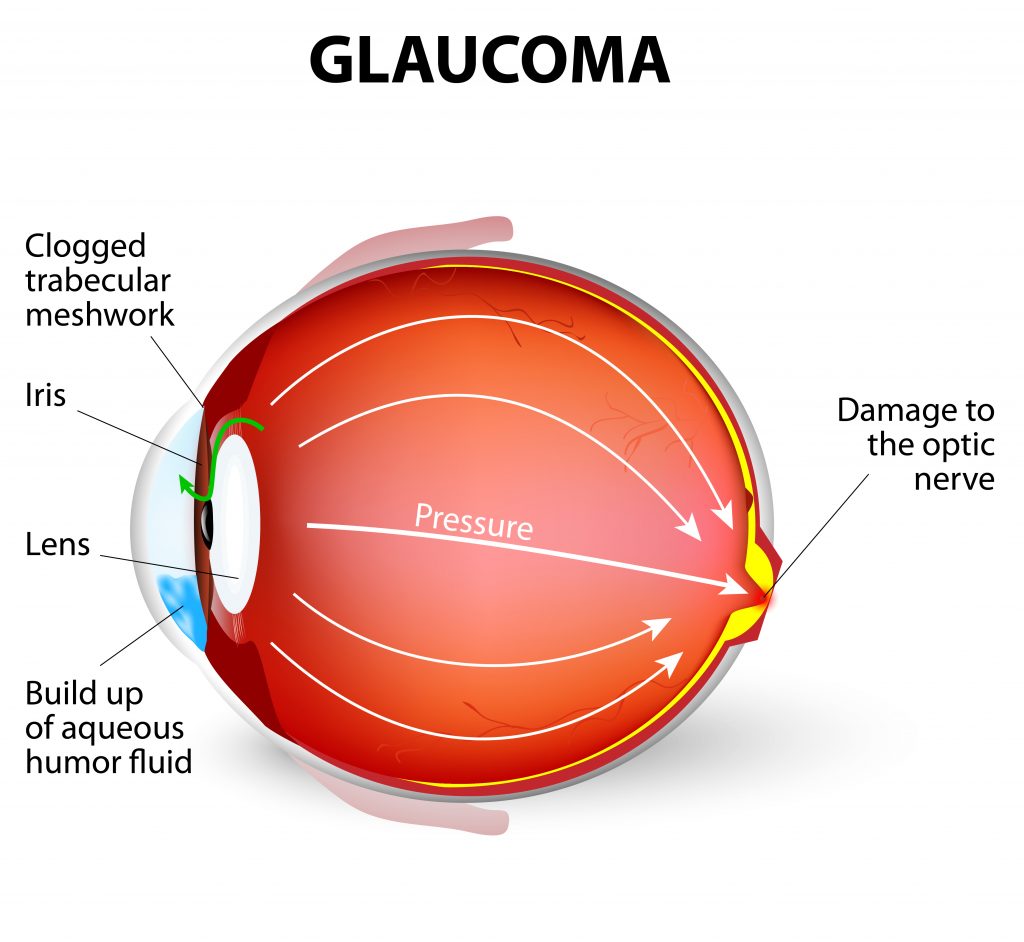
Glaucoma is often referred to as the “silent thief of sight.” It is called this not only because it is usually asymptomatic in its early stages but also because the vision loss caused by glaucoma can be significant and permanent.
Keep reading to learn more about glaucoma, including whether or not it can be cured or reversed!
What is Glaucoma?

Glaucoma is a group of eye diseases characterized by high levels of intraocular pressure that damage the optic nerve. The optic nerve is the structure within the eye that carries visual information from the eyes to the brain.
Four types of Glaucoma to know about are open-angle glaucoma, angle-closure glaucoma, congenital glaucoma, and secondary glaucoma. Of these four types, open-angle is the most common type.
Open-Angle Glaucoma
Open-angle glaucoma occurs when the eye’s drainage canals become blocked or clogged, and ocular fluid cannot properly drain from the eye. As this fluid builds up, it increases the pressure within the eye, leading to optic nerve damage.
Open-angle glaucoma is the most common type of age-related glaucoma and accounts for the majority of cases. It can take years to develop, and there are usually no symptoms in the early stages of the condition.
Angle-Closure Glaucoma
Angle-closure glaucoma occurs when the eye’s angle becomes narrow, which blocks fluid from properly draining, increasing intraocular pressure. It is much less common than open-angle glaucoma.
While angle-closure glaucoma can develop slowly, it more often comes on suddenly in an acute attack. An acute attack of angle-closure glaucoma is a serious emergency, and medical attention should be sought immediately to limit permanent vision impairment.
Congenital Glaucoma and Secondary Glaucoma
Congenital glaucoma results from abnormal development of the eye’s drainage canals. It is often present at birth and usually is genetic.
Secondary glaucoma occurs as a complication or side-effect of another health condition. It can be caused by chronic health conditions like diabetes and hypertension, use of corticosteroids, other eye diseases, including cataracts, or previous eye injuries or trauma.
What Are The Symptoms of Glaucoma?

The symptoms of glaucoma include:
- Hazy, blurred or narrow vision
- Blind spots in peripheral vision
- Halos around sources of light
- Eye redness
- Eye pressure or pain
- Headaches
- Nausea
Because glaucoma usually develops over a long period of time, often symptoms do not become noticeable until the condition is more advanced. The exception to this is an acute attack of angle-closure glaucoma.
Why Glaucoma Cannot be Cured or Reversed
There are two primary reasons why glaucoma cannot be cured or reversed: permanent damage to the optic nerve and the chronic nature of the eye condition. Once the nerve fibers in optic nerve tissue have been damaged, they die off and cannot regenerate.
The loss of optic nerve tissue leads to permanent vision loss. Glaucoma is a chronic condition, meaning it cannot be cured, only managed with treatment.
Even with treatment, the eye condition can continue to progress and further impair vision.
How is Glaucoma Managed?
While glaucoma cannot be cured or reversed, treatment options are available to manage the disease and prevent further vision loss. The aim of all glaucoma treatments is to lower intraocular pressure and prevent further optic nerve damage.
Treatments for glaucoma include medicated eye drops, laser therapy, and surgical interventions.
Medicated Eye Drops

Medicated eye drops are usually the first treatment prescribed to glaucoma patients. Eye drops help control glaucoma by reducing fluid production, increasing fluid drainage, or a combination of both.
Most glaucoma patients will need to use medicated eye drops to manage glaucoma for the rest of their lives following a diagnosis. If eye drops alone aren’t controlling glaucoma, they may be combined with other types of treatments.
Laser Therapy
Laser therapy treatments are an option for some glaucoma patients. They can be more effective than medicated eye drops and less invasive than surgical options.
The most common types of laser therapy are laser trabeculoplasty and laser peripheral iridotomy. During a laser trabeculoplasty, a beam of laser light is used to unclog and widen the eye’s drainage canals to increase fluid outflow.
This laser treatment is most successful at treating the early stages of open-angle glaucoma. A laser peripheral iridotomy uses a laser to create a microscopic hole in the iris to relieve pressure and increase the flow of fluid from the front of the eye.
It can be performed on patients with open-angle or closed-angle glaucoma.
Surgical Interventions
If other treatments for glaucoma have not been successful or a patient is not a good candidate for laser therapy, an eye doctor may recommend a surgical intervention. These interventions include trabeculectomy, valve implantation, and MIGS.
During a trabeculectomy, a new pathway for fluid drainage is created in the eye to help prevent further vision loss. During this procedure, a small flap is created in the sclera, the white part of the eye, which causes a bleb, or bubble, to form and creates an additional way for eye fluid to drain.
Valve implantation involves surgically implanting a tiny tube, or stent, in the eye’s drainage canal. The stent prevents blockage, widens the drainage canal, and increases fluid drainage.
MIGS, which stands for minimally invasive glaucoma surgery, is one of the latest advancements in glaucoma treatment. It is less invasive than other surgical interventions and poses a lower risk for post-surgery complications.
MIGS can implant a stent and remove tissue to increase fluid drainage and clear drainage canals. MIGS procedures are most successful at treating the early stages of glaucoma.
While glaucoma cannot be cured or reversed, there are effective treatments that can prevent further vision loss. From medicated eye drops to innovative MIGS, a glaucoma diagnosis does not have to lead to the complete loss of your precious vision.
Do you want to learn more about glaucoma or determine if you might be at risk for this condition? Schedule an appointment at Northeastern Eye Institute in Scranton, Clarks Summit, Dallas, Forty Fort, Hamlin, Honesdale, Hazelton, Peckville, Montrose, Mountaintop, Pocono Summit, Tuckhannock, Wilkes-Barre, PA, at 570-342-3145 today!